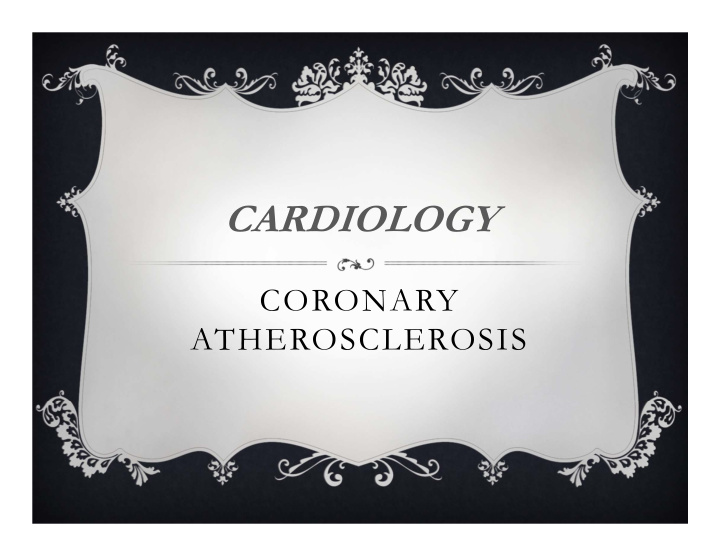



CARDIOLOGY CORONARY ATHEROSCLEROSIS
CARDIOPUMONARY BLOOD FLOW REVIEW http://www.youtube.com/watch?v=VUtehbgbp Rk&feature=player_detailpage#t=268s
The Coronary Circulation http://www.youtube.com/embed/7JHFeXl6kH4 ?feature=player_detailpage
VASCULAR BIOLOGY The vascular network consists of both small and large vessels specifically designed to accommodate varying levels of blood flow and pressure, depending upon the location within the body (e.g. large conduit vessels versus small microvessels within the capillary beds in tissues). In addition, layered within the vascular tissue is a diverse population of cell types, including endothelial cells, smooth muscle cells, pericytes, fibroblasts, and other connective tissue cell types. The combination of these cell types make up the vascular tissue and form tight junctions or connections, which allow for permeability for both passive and active transport across the vessel wall.
ATHEROSCLEROSIS � VASCULAR BIOLOGY � PLAQUE DISRUPTION � COMPLICATIONS OF ATHEROSCLEROSIS
ISCHEMIC HEART DISEASE DECREASED MYOCARDIAL • OXYGEN SUPPLY INCREASED MYOCARDIAL • OXYGEN DEMAND PATHOPHYSIOLOGY OF • ISCHEMIC HEART DISEASE ISCHEMIC SYNDROMES • (ANGINAS) ELECTROCARDIOGRAM • REVASCULARIZATION • PTCA (BALLOON) • CORONARY STENTS • BYPASS GRAFTING •
BIOLOGICAL PROGRESSION OF CORONARY ATHEROSCLEROSIS http://www.youtube.com/watch?feature=player_detailpage&v=mCYAOeEe6-w#t=214s
Hyp Hypot Peri MYOCARDIAL OXYGEN BALANCE MYOCARDIAL OXYGEN BALANCE Myocardial oxygen balance is determined by the ratio of oxygen supply to oxygen demand. Increasing oxygen supply by increasing either arterial oxygen content or coronary blood flow leads to an increase in tissue oxygen levels (usually measured as the partial pressure of oxygen, pO 2 ). Increasing oxygen demand alone (i.e., myocardial oxygen consumption) decreases tissue oxygen levels. Normally, when oxygen demand increases there is a proportionate increase in coronary blood flow and oxygen supply so that tissue oxygen levels are maintained during times of increased oxygen demand. This increase in blood flow is performed by local regulatory mechanisms. This tight coupling between oxygen demand and coronary blood flow is impaired in coronary artery disease because oxygen supply is limited by vascular stenosis. If the oxygen supply/demand ratio is reduced either by a decrease in oxygen delivery relative to demand, or by an increase in demand relative to supply, then tissue hypoxia results
CHEST RADIOGRAPHY � The Cardiac Silhouette
NORMAL 12 LEAD EKG
. Electrocardiography Electrocardiogram on animals, usually for diagnosis of heart abnormalit
ECG leads Location of MI Coronary Artery II, III, aVF Inferior MI Right Coronary Artery Anterior or Anteroseptal Left Anterior Descending V1-V4 MI Artery V5-V6, I,aVL Lateral MI Left Circumflex Artery Left Circumflex Artery or ST depression in V1, V2 Posterior MI Right Coronary Artery
VIRTUAL CORONARY PTCA W/ STENT PLACEMENT http://www.youtube.com/watch?v=N7nghr9Tp SU&feature=player_detailpage
LEFT HEART CORONARY CATHETERIZATION WITH LEFT VENTRICULOGRAM WITH AORTIC RUN- OFF FOLLOWED BY PTCA AND MUTIPLE CORONARY STENTING OF THE RIGHT DISTAL CORONARY ARTERY http://www.youtube.com/watch?feature=player _detailpage&v=JeH4zPzQgRc
THE APPLICATION AREAS OF ECG DIAGNOSIS
Recommend
More recommend